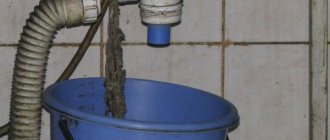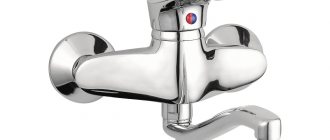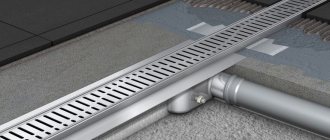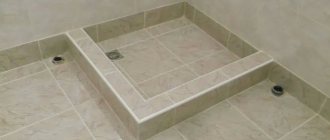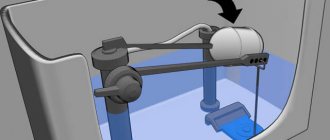Causes of odors from sewer pipes
Musty air in the bathroom can occur not only because there is a wet rag lying around somewhere. We are talking about the smell that comes from the pipes. There may be several reasons for the appearance of an unpleasant odor from the pipeline.
This:
- malfunction of the water seal (siphon);
- contaminated pipes - in this case it is necessary to clean them;
- unreliable fastenings of connecting elements.
Some mask the unpleasant smell from the sewer using air fresheners. However, this is only short-term help; the situation will get worse over time. Therefore, it is imperative to find out the cause of the problem and eliminate it - only in this case will you be able to get rid of it. Therefore, regarding the question “there is a smell from the pipes, what should I do?” All that can be said is to find out why this is happening.
Why does the shower smell? How to eliminate the causes of odor in the shower.
The shower room and bathroom are a place where we rest and relax. It is very important that there is an appropriate atmosphere here. Fragrant smells, light music. An unpleasant smell in the shower is completely out of place. However, as in the whole house.
Causes of odor in the shower
- The drain built into the shower stall does not have a water seal.
- There is no water in the water seal or it is clogged.
- Malfunction of the drain pipe.
How to get rid of the smell in the shower?
- You can find out whether a water seal is built into the shower drain by visual inspection. It is enough to remove the facing grille from the ladder.
Problems with siphon and water seal
The main problems associated with improper operation of the water seal and siphon are:
- Noticeable sagging of the corrugated pipe. The material from which the corrugation is made means that over time the product will lose its elasticity and other qualities, which is why problems will certainly arise in the future. This does not depend on the quality of the pipe - any corrugated products will begin to sag over time. This is inevitable, and sooner or later the corrugation will have to be replaced.
- If the siphon was installed incorrectly, difficulties may also arise during operation. This problem is often encountered by those who decide to carry out sewer work on their own, without the help of professional plumbers. This is due to the fact that installing a siphon requires compliance with certain rules, and the slightest mistakes can lead to problems.
- It is recommended to listen to the sounds of water flowing down the drain. An incomprehensible rustling or gurgling sound is a sign of a broken water seal. This indicates that there is no water in the device, which prevents odors from the sewer from entering the house. In addition, a vacuum plug may form in the riser. Therefore, if you suspect a malfunction of the water seal, you should take immediate action - if you do not fix the problem with the siphon, the smell from the sewer pipe in the bathroom will constantly come out. Read also: “How to clean pipes at home and what is best to use for this.”
Prevention recommendations
In order not to think about how to eliminate sewer odors in the bathroom, follow preventive measures:
- Entrust the work only to professional plumbers, in whose experience and knowledge you are confident: they will set the required slope of the sewer pipes, seal the joints, and check for the presence of water seals. A properly installed system will not cause problems with blockages or odor in the future.
- Carry out regular (once every 2-3 months) cleaning of the sewer system with boiling water, soda or other gentle substances.
- Do not throw foreign objects into the toilet: only toilet paper and flushable toilet rolls.
- Leave the door open after taking a bath. High temperature and humidity are the ideal atmosphere for fungi and mold growth. Even if the hood is running in the bathroom, it won’t hurt to open the door for 30-60 minutes.
- Install filter meshes - thanks to them, most of the garbage will not be allowed to go down the drain, but simply thrown into a bucket.
- Rinse the siphon as soon as you notice that the water is getting worse.
- Get rid of leaks, cracks and other troubles in a timely manner. In the case of sewer pipes, you cannot wait - the longer the problem exists, the more difficult it will be to solve.
Take the necessary measures or seek professional help immediately as soon as you notice an odor problem. Chronic inhalation of ammonia and methane can lead to nervousness, irritability, and other more serious health problems.
Possible installation errors
Errors during the installation of siphons can be as follows:
- The pipe is not immersed in the water correctly. This oversight is very common, because of this, an unpleasant aroma penetrates the room through the space between the walls of the siphon and the water.
- Tension when installing corrugated pipe. Plumbers who are not particularly skilled can also commit negligence.
- Shortened siphon partition. This causes the water seal to be too small, it periodically breaks and the water escapes. There is only one way to solve this problem - replace the siphon.
- The corrugated pipe was bent. In such a situation, you can bring it to its normal position and secure it with electrical tape. But this is only a temporary measure; in the future you need to buy a new pipe.
- Incorrect installation of the siphon (for example, upside down).
- Lack of plumbing maintenance. Prolonged stagnation of water can cause evaporation of water stagnant in the siphon. Namely, this liquid, which is constantly present in the device, does not allow bad odors to penetrate into the room from the sewer.
These situations are usually the main reasons for the formation of an unpleasant odor. Contamination of pipes can occur even during short-term operation of the pipeline. In these situations, not only a slight coating forms on it, but also real traces of rot and mold in the system, as well as various manifestations of bacterial activity.
An unpleasant smell from pipes in the bathroom can also occur if the diameter of the riser is too small. According to standards, it must be at least 11 centimeters. If this value is less, the passage of drains may be difficult, and this will cause blockages, which, in turn, will lead to the appearance of an unpleasant odor.
In this situation, replacing pipes with products with a larger diameter should be done by professionals who can do the job correctly. Trying to solve a problem on your own often leads to an even worse situation.
Where does the smell come from?
In order to understand why the shower smells like sewer, you need to understand the general structure of the sewer system. This is a system of pipelines through which liquid moves by gravity. The drains are not under pressure, so most of the time the pipelines are empty. This allows sewer gases produced by organics and other components of liquids to spread freely.
Any change in gas pressure in the system contributes to their release into the atmosphere. When there is a sewer smell from the shower stall, it means that gas is passing through the drain hole - the drain. This is the only possible option, since the cabin is not connected to the sewer anywhere else. Trying to find the cause in other nodes or elements is pointless.
Siphon, water seal
The smell of sewerage from the drain indicates a connection between the cavity of the pipelines and the atmosphere of the house. This should not be allowed, since gases not only deprive apartment residents of comfort, they have a harmful effect on people’s well-being. A siphon is used to isolate the cavity of the system and the atmosphere of the house. This is a bend in the outlet pipe that constantly contains water. It forms a water seal - a kind of plug that does not let air from the sewer into the apartment (and vice versa).
The smell of sewage from the shower indicates the presence of one of two reasons:
- improper operation of the water seal;
- absence of a siphon (and, accordingly, a water seal).
Many apartment owners or careless plumbers do not install a siphon at the outlet. The shower cabin is not yet a very common element, so not everyone can install it correctly. Moreover, if the device is connected by an invited specialist. He won’t have to wonder why his shower smells like sewage. Often the height of the cabin simply does not allow the installation of an incorrectly selected ladder (exhaust element), so its design is changed. At the same time, many consider making a water seal an optional item. A regular corrugation is connected to the drain hole, which is connected to the sewer. At this point the issue is considered resolved. True, after a while questions arise - why does the new shower smell like sewer and how to fix it.
Why does the water seal sometimes not work?
Incorrect operation of the water seal can be caused by two reasons:
- The height difference in the siphon is too small. The water plug is too small, so even a small pressure in the sewer can squeeze it out;
- significant loads on the water seal caused by large pressure drops in sewer pipes.
The first option is most often found on imported shower cabins. They are designed for use in a private house where the sewer riser is not very long. When using the system, no significant pressure can arise.
The second option is typical for apartment buildings. When multiple toilets or bathtubs are flushed at the same time, strong negative pressure builds up in the riser. It pulls the water seal inside the pipe and often breaks it. Hence the smell of sewage in the shower stall.
There is another option for gas getting out of the system. When pressure increases in the pipes, it can bubble through the water seal. At the same time, the water plug will not necessarily break; gas bubbles will simply pass through the siphon and enter the apartment.
The main reason for such problems is poor functioning of the drain pipe. It is sometimes clogged with debris or frost, causing the internal cavity to lose connection with the atmosphere. Sometimes residents of the upper floors, not understanding its purpose, simply cut off an unnecessary piece of pipe. As a result, any drainage of water changes the pressure in the riser. After this, the appliance with the smallest and weakest water seal will begin to smell like sewage. Usually this is a bath or shower.
Also read: The toilet on the top floor smells like sewage: why does it smell and what to do?
Ventilation pipe problems
An equally common cause is ventilation pipes. All it takes is a slight twist or deviation from the correct location to create an unpleasant odor. Also, due to prolonged use, plaque may develop inside the pipe. In such a situation, the pipeline must be cleaned so that it can again perform its function.
To prevent this from happening, it is advisable to periodically inspect the ventilation and promptly remove contaminants that could become a source of stench.
Minimizing joints in pipes
Joints are not only the weakest element in terms of leaks, but also a place where dirt and plaque easily accumulate, and where the characteristic smell is not far away. Often a huge number of joints are made when connecting the bathtub to the sewer. Unfortunately, it is only possible to properly detect and remove dirt from the joints by disassembling the drain. Chemical pipe cleaners will give a temporary and not the best effect.
If possible, try to reduce the number of joints as much as possible.
Condensation Formation
The reason for the formation of condensation on sewer pipes is the difference in temperatures outside and inside the pipe. Because of this, mold and mildew may appear in places where condensation accumulates, causing an unpleasant odor. In addition, they are also very harmful to health. The fungus appears in rooms with high air humidity, and it is extremely difficult to get rid of it.
This problem can be avoided if you constantly monitor the condition of the pipes. If condensation is detected, the pipeline should be wiped and insulated (for more details: “How to remove condensation from cold water pipes - eliminating causes and consequences”). Thanks to this, in the future there will be no large temperature difference, and therefore the formation of wet marks.
The pipes should be located in such a way that they are easy to reach. If they are located in a place where access is difficult, eliminating the problem will become problematic. The slightest crack in a pipe can lead to the need to dismantle a large part of the room to get to it.
Siphon bottle
The bottle-shaped siphon is not flexible, its design includes:
- cylinder;
- end cap;
- sewer;
- attached pipe.
When installing a bottle siphon, the drain hole must be above the lower end of the pipe, located vertically.
This allows a lock to be formed in the cylinder. Water accumulates in the flask and creates a plug to block the unpleasant odor. You can clean the siphon after disassembling the system.
Installing a bottle siphon is simple and does not take much time.
Ways to eliminate unpleasant odor from sewers
If there is a smell from the pipes in the bathroom, what to do:
- If the corrugated pipe sag, you should use clamps. They will bring the pipe into its natural position, and this will help remove the unpleasant odor.
- If the bathroom plumbing will not be used for some time, it is recommended to pour a small amount of vegetable oil into the drains. It will create a film that will prevent water evaporation.
- If pipes become depressurized, the joints should be lubricated with sealant.
- If the pipeline is clogged, a plunger or a special cable can help.
These methods are mechanical ways of eliminating the problem. You can also use special tools, for example, “Mole”, “Domestos”. These compounds are quite effective, but they can destroy rubber seals in pipes.
Restoring the tightness of the sewer system
Cracks, punctures, ruptures and other defects may form on the siphon, pipes, and joints that impair the tightness of the sewer system. These places allow unpleasant odors to penetrate into the bathroom, and water also leaks through them, which sooner or later will also make itself felt with a characteristic aroma. The procedure for this case is as follows:
- thorough inspection and leak detection. Run hot water down the drain and inspect the pipes with a flashlight. You can use napkins or toilet paper - they will get wet upon contact with the problem area;
- if a defect is found on a non-separable element, it needs to be replaced. Poor quality pipes are often to blame;
- if water seeps through the joint between different elements, then first you can try tightening the connection or replacing the sealing gasket. You can also try sealing the joint with FUM tape;
- As a preventative measure, make it a rule to use silicone when installing all gaskets.
The shower smells like sewer
After taking a shower or bath, moisture accumulates in the room, which does not have the best effect on the atmosphere and causes an unpleasant aroma. The door to the bathroom should not be constantly closed - at least sometimes it should be opened.
Video
We have prepared for you an interesting video on how to clear a blockage using a modern plumbing cable and drill.
To ensure that water flows normally into the drain and there is no unpleasant odor, clean the pipe using the method that suits you best. Don’t forget to clean your pipes four to six times a year as a preventative measure. To reduce problems with water drainage, buy a drain mesh. It blocks most of the debris that may end up in the siphon.
There are a number of reasons for an unpleasant odor coming from the opening of the shower stall.
The unpleasant sensation of volatile odors is often caused by gases from the drain that flow back into the shower drain. In addition, the exhaust fan may not be working properly. If the unpleasant sensation of smell is not caused by one of these problems, the presence of odorous substances not coming from the drain may in fact be a separate problem in the bathroom.
Mold control
A humid, warm environment, lots of wet towels and gowns, and problems with ventilation are ideal conditions for mold to grow.
If you have ever heard this unpleasant smell, then you understand what we are talking about. Not only does it become difficult to be in the bathroom, but also inhaling such air is very dangerous. Particularly dangerous is black mold, which can affect any surface and ultimately lead to insomnia, dermatitis, asthma, pneumonia and even lung cancer. There are many ways to combat mold:
- ready-made special products are the most reliable option. Modern fungicides do an excellent job even with black mold, but when the mold has been overcome, it is better to periodically treat it with antiseptic agents for preventive purposes. Ideally, clean off all mold-affected layers of finishing, since the mycelium takes its roots very deep;
- Bleach is a worthy replacement for special products. It is diluted with water in a ratio of 1:10, then the whole thing is applied with a brush to the affected area;
- vinegar can also be sprayed onto the affected area and washed off with a damp cloth after a while;
- peroxide is poisonous to mold, but be careful - it will discolour painted surfaces. A 3% peroxide solution is applied directly to the damaged area;
- ammonia is mixed with water in a 1:1 ratio. Works effectively on hard, non-porous surfaces. Do not mix with bleach;
- borax (1 glass) is diluted in water (2.5 l), and the solution is applied with a stiff brush;
- also use tea tree oil, lavender and rosemary oil, potassium permanganate, soda, and citric acid. The smell of mold can remain even after it is removed, and you can eliminate it with baking soda. It is left in the place where the fungus lived, and then collected with a vacuum cleaner.
